Galaxies are arguably the most difficult class of deep-sky objects to observe with a telescope, other than exotic objects like extremely small planetary nebulae. This is really for three reasons. Firstly, galaxies are severely affected by insidious light pollution due to their wispy nature. Second, due to their uniform emission of light, telescope filters cannot be used on galaxies to enhance contrast (or partially compensate for light pollution’s effects). Third, many galaxies require hard-to-find combinations of observation conditions and equipment. All galaxies benefit from a transparent and dark sky, but this may be hard to find in conjunction with the consistently steady atmosphere recommended for seeing small details. Other galaxies require a combination of a large aperture and a wide field of view to be seen in their entirety, which can demand expensive eyepieces and even custom telescopes.
This article is meant for Northern Hemisphere observers, though many of the objects listed here can be seen from the Southern Hemisphere (albeit some not as well due to their low altitudes in the sky). We’ve marked when each galaxy is roughly best observable throughout the year and given a general outline of their locations in the sky as best we can.
This list was compiled based mostly on observations with a 14.7” and 6” telescope from dark (SQM 21.8-22.0/Bortle 1 or 2) and suburban (SQM 20.5/Bortle 5) skies. However, all of the objects listed here can be seen with a telescope of 6” aperture with very dark skies; most are visible with an 8″, and a 10” will easily reel in any of them provided your skies are somewhat dark. Light-polluted skies worse than Bortle 5 (< SQM 20.0) will make observing anything outside of the top 25 objects on our list impossible. For best results, Bortle 4 (> SQM 21.0) or better skies are really what you need to observe galaxies.
Contents in this article:
Galaxies recommended to watch with 6” or less aperture
1: The Andromeda Galaxy (M31) & Companions
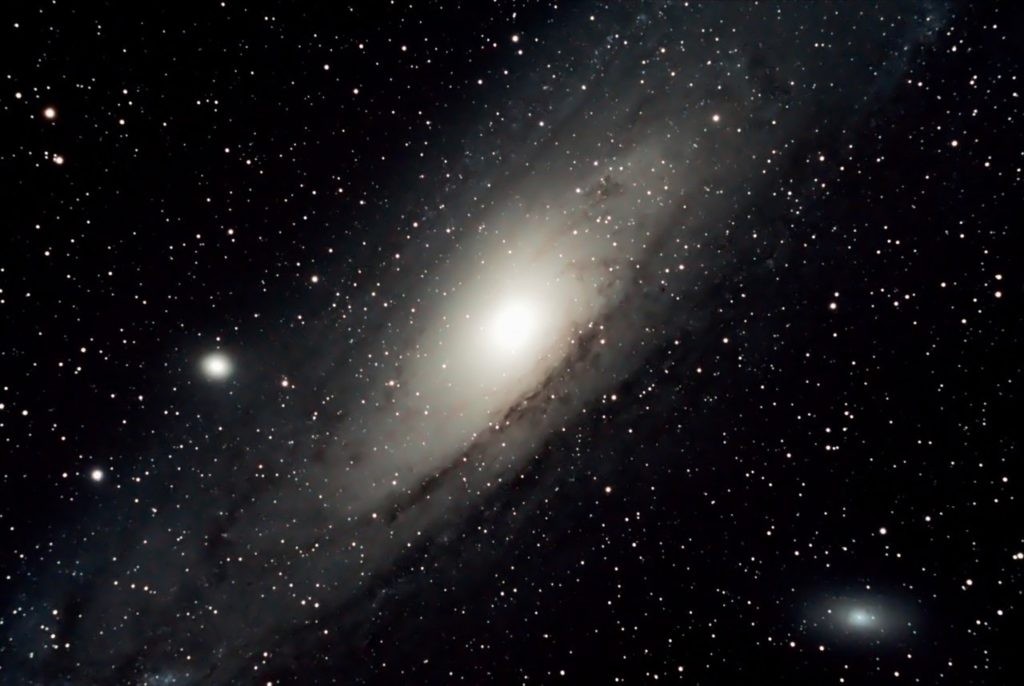
- Best seen: July-March
- Minimum aperture recommended: 3”
- Distance: 2.5 million light-years away
- Where: Next to V Andromedae, or about halfway between 31 Andromedae and Shedar if you are under light-polluted skies and can’t see V Andromedae
Undoubtedly the most famous galaxy of them all (at least by name), the Andromeda Galaxy is the closest true spiral galaxy to us that we can see with a telescope. The Large Magellanic Cloud is far closer, but smaller and debatably a spiral galaxy or not, and in any case, it’s not visible from the Northern Hemisphere.
Andromeda can be seen with the naked eye from suburban or rural skies fairly easily, and large astronomy binoculars or a 3” telescope will show a dust lane. A 4” or larger telescope reveals M32, a companion elliptical galaxy that may have once been a spiral itself and was eaten by Andromeda, while a 6” adds the fainter M110 and will begin to show that the dust lanes actually wrap all the way around the galaxy. An 8” or 10” telescope reveals NGC 206, an embedded star cloud within M31. With an 8” or bigger telescope, M31’s core appears ridiculously bright and is visible even from a light-polluted city.
A 12” or bigger telescope can actually resolve individual stars in NGC 206 and will be able to show you G1 or Mayall II, a globular star cluster that is a part of the Andromeda Galaxy and much bigger/brighter than any of our own. G1 is located a few degrees away from Andromeda in the sky and remains fuzzy and unresolved through anything under around 25” in aperture. A 14” or larger telescope shows additional star clouds and even nebulae in M31, along with up to dozens of globular clusters as faint, star-like points. Read our guide on how to observe the Andromeda galaxy with your telescope.
M31 is due to collide with us in a few billion years’ time, by which time the Sun will be in its death throes, having become a red giant and scorched or outright consumed the Earth. The collision will probably not result in widespread destruction or the loss of stars. Instead, the merger will probably produce an elliptical galaxy with dust lanes and other irregular structures like Centaurus A (see below).
2: NGC 253, the Sculptor Galaxy
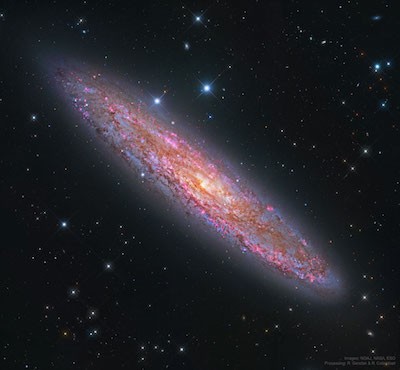
- Best seen: August-January
- Minimum aperture recommended: 3”
- Distance: 12 million light-years away
- Where: Below Diphda, close to Alpha Sculptoris
Visible to the naked eye under extremely good conditions, the spiral galaxy NGC 253 is rather low in the southern sky and is best observed from southerly latitudes. Even a 3-4″ telescope shows some mottling and dust lanes. Larger telescopes make the galaxy brighter but don’t reveal much, often due to the less-than-ideal atmospheric conditions when aimed near the horizon. A 12” or larger telescope under good conditions shows some patchy H-II regions (i.e., nebulae) within the galaxy.
3: M81 & M82
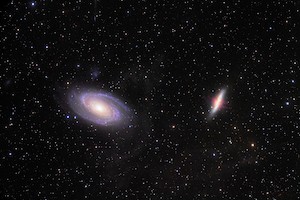
- Best seen: February-August
- Minimum aperture recommended: 3”
- Distance: 12 million light-years away
- Where: Imagine a line between the “bowl” stars of the Big Dipper Phecda and Dubhe, and continue along it by about the same distance between the two.
M81 and M82 are actually visible to the naked eye under reasonably dark conditions, on account of their proximity to us and the fact that their brightness is combined due to their closeness together in the sky. Both are spiral galaxies, but M82 passed too close to M81 long ago and was torn apart. M82 today is an irregular “starburst” galaxy with dark lanes of disturbed hydrogen gas passing perpendicular to its disk, and a rate of star formation several times that of our own galaxy, despite being a fraction of the size of the Milky Way. These dark lanes can be seen with even a 4” telescope from the suburbs, as M82 is extremely luminous and the lanes are extremely high in contrast.
Meanwhile, M81 is a more typical spiral galaxy, and the arms can be seen with an 8” or bigger telescope. NGC 3077, an elliptical galaxy belonging to the same group as M81 and M82, sits in the same field of view, and should be visible with a 6” or larger instrument but lacks detail. Also nearby is NGC 2976, an irregular galaxy like M82 and with some vague dusty mottling visible with an 8” or larger scope.
4: M33, the Triangulum Galaxy
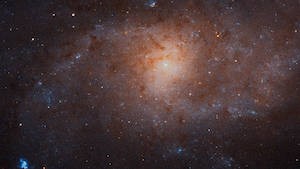
- Best seen: June-February
- Minimum aperture recommended: 3”
- Distance: 2.75 million light-years away
- Where: About halfway between Mirach and Hamal
M33 is the next-closest significant galaxy to us after M31, and is visible under dark skies to the naked eye – or with binoculars and small wide-field telescopes from suburban or better locales. Light pollution completely removes any detail or washes out the galaxy altogether, but a bright H-II region (a nebula like our own Orion Nebula), NGC 604, is visible in a 4” or larger telescope, while a 6” or larger telescope brings out more H-II regions and hints of spiral arms. A 10” or bigger telescope clearly resolves the full spiral structure of M33.
M33 will probably collide with M31 shortly before it slams into our own Milky Way, though there is a slight chance our own galaxy consumes it first or M33 is flung away from the two larger galaxies and escapes destruction.
5: M94
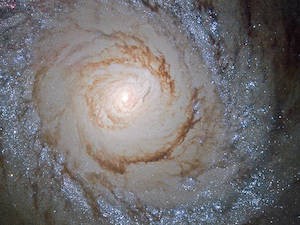
- Best seen: February-August
- Minimum aperture recommended: 3”
- Distance: 16 million light-years away
- Where: Next to Cor Caroli
M94 is a spiral galaxy, and unusually bright for one viewed face-on. You can see M94’s bright center and dimmer outer halo with even a 3” telescope under decent conditions, and an 8” or larger telescope reveals the tightly-packed dust lanes – part of its spiral structure – near the center. M94 is visible even from fairly light-polluted locales owing to its extreme brightness and fairly small apparent size, though detail will be less evident.
6: M64
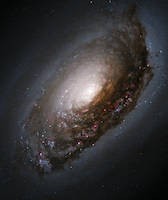
- Best seen: March-July
- Minimum aperture recommended: 4”
- Distance: 24 million light-years away
- Where: ⅓ of the way between Diadem and Al Dafirah in Coma Berenices
Like M94, M64 is a fairly bright spiral galaxy and, owing to our vantage point, features an extremely high-contrast dust lane right in front of it. This dust lane is visible even with a small telescope and light-polluted skies.
7: The Leo Trio (M65, M66, NGC 3628)

- Best seen: February-June
- Minimum aperture recommended: 4”
- Distance: 32 million light-years away
- Where: This group is quite easy to find, a little below the bright star Chertan in Leo.
All three galaxies in the Leo Trio are similar to our own Milky Way and Andromeda in size and shape, and thus resemble the Local Group of galaxies containing us, Andromeda, and the nearby Triangulum Galaxy (M33). Thus, the group looks a lot like we would from 32 million light-years away, which is the distance at which they reside. M65 has tighter arms, resembling Andromeda, and shows a fairly obvious dust lane that appears to wrap around the core with larger instruments, while M66 has a less orderly barred spiral pattern with some dust that resembles our own Milky Way.
The Messier catalog objects were all, of course, discovered or corroborated by Charles Messier with a 6” telescope in the 1700s. NGC 3628 is conspicuously absent from the catalog, and it’s easy to see why. The galaxy is a lot fainter and lower in contrast than M65 or M66, with its puffy disk and dark dust lanes evading the eye completely under light-polluted skies or in a small telescope.
8: NGC 404, Mirach’s Ghost
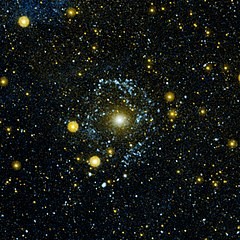
- Best seen: August-February
- Minimum aperture recommended: 5”
- Distance: 16 million light-years away
- Where: Right next to Mirach
NGC 404 is easy to confuse with glare or a smudge on your eyepiece, as it is positioned right next to the 2nd-magnitude red supergiant star Mirach. NGC 404 is one of the closer galaxies to us at only 10 million light-years away, and it is fairly easy to see with even only a few inches of aperture if you can tease it out of Mirach’s glare. NGC 404 lies outside our Local Group of galaxies well beyond Andromeda, and has only one nearby companion – a tiny galaxy known as Donatiello I, discovered by an amateur astronomer in 2016 with a modest astrophotography setup (though invisible without 20” or more of aperture).
9: NGC 2683, the UFO Galaxy
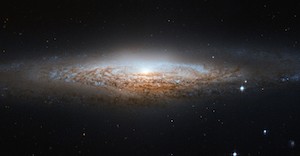
- Best seen: November-April
- Minimum aperture recommended: 5”
- Distance: 30 million light-years away
- Where: Near Sigma Cancri, north of Zubanah
NGC 2683 is a bright edge-on spiral galaxy that shows fairly obvious dust lanes in even a small telescope, just below its bright core and dimmer disk. There’s not a lot else to say about it as it has no visible neighbors and little is known about the galaxy.
10: M104, the Sombrero Galaxy
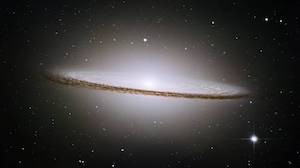
- Best seen: April-July
- Minimum aperture recommended: 5”
- Distance: 28 million light-years away
- Where: ⅓ of the way between Algorab and Porrima
M104 is a lenticular galaxy. Its extremely prominent dust lane, which gives it its name, makes it an easy catch under light-polluted skies, though its small size requires a 6” or larger telescope in order to achieve sufficient magnification to resolve it without losing too much image brightness. A 10” or larger telescope reveals a bumpy, fur-like appearance to the disk.
11: The Virgo Cluster
- Best seen: March-July
- Minimum aperture recommended: 5”
- Distance: Between 50-70 million light-years away
- Where: Centered halfway between Vindimiatrix and Denebola
The Virgo Cluster is so vast and comprehensive that giving it only one listing almost seems unfair. A 4” telescope reveals a handful of galaxies, but a 6” or larger instrument will show you 50 or more from suburban skies and explode to over 100 under dark ones. The cluster spans 8 degrees, or 16 times the size of the full moon, in the sky. Bright members include the famous M87, which has a supermassive black hole that was the first to ever be imaged, along with a jet of superheated gas shooting out of it (which unfortunately requires a 25” or bigger instrument to see). The majority of the galaxies in the Virgo Cluster are unfortunately either elliptical galaxies, or are spiral/lenticular galaxies with detail that is too low in contrast or simply too dim to observe, so the fun here really is just in sheer numbers. A 10” or bigger telescope will show you a few interesting edge-on spiral galaxies in the cluster.
12: Centaurus A (NGC 5128)
- Best seen: May-July
- Minimum aperture recommended: 5”
- Distance: 16 million light-years away
- Where: Below Iota Centauri and probably barely above your southern horizon
Centaurus A is a monster elliptical or lenticular galaxy, one of the closest types to us. As such, it is extremely bright, and visible to the naked eye when high in the sky. Unfortunately, Centaurus A sits far south in the night sky, and is best seen at southerly latitudes. As such, the galaxy is not visible to the naked eye for Northern Hemisphere observers, as it is usually barely above the horizon and considerably dimmed by the hundreds of miles of air we have to look through. However, Centaurus A can be seen from anywhere south of 43 degrees latitude and the author has managed to spot it with cheap 7×50 binoculars from a fairly light-polluted area just outside New York City (41 degrees north latitude). A 6” or larger telescope will show a dark dust lane going across the center of the galaxy.
Centaurus A’s dust lanes and other structures that are out-of-place for an elliptical galaxy indicate that it is probably the result of one of more mergers between similarly sized spiral galaxies. Thus, Centaurus A is a window far into our own future in which M31 will collide with our own Milky Way and produce a similar result.
13: The Leo Quintet (M96 group)
- Best seen: February-June
- Minimum aperture recommended: 6”
- Distance: 32 million light-years away
- Where: This group is quite easy to find, a little below the bright star Chertan in Leo.
This group in Leo is easy to find, between the stars Iota and Kappa Leonis which can be seen with the naked eye under decent viewing conditions; if not, they’re halfway between the much brighter Chertan and Regulus if you aim just a little bit below an imaginary line connecting them.
M105 is a big and fairly bright elliptical galaxy with nearly-identical NGC 3384 right next to it – one wonders why Messier missed the latter. Dim NGC 3389 is visible below, though you may need a bigger telescope to get it to show up. A little off to the west, though probably still in the same low power field of view, are M95 and M96, which are similarly near-identical twins of each other like M105 and NGC 3384. The cores of both galaxies are brighter than their outer halos, and both are actually spirals. M95 features a bar that’s visible in a 12” or larger telescope, but the spiral arms of both galaxies are too tightly packed to detect with a typical amateur instrument.
14: M51, the Whirlpool Galaxy
- Best seen: February-August
- Minimum aperture recommended: 6”
- Distance: 31 million light-years away
- Where: Between 24 CVn and HIP 65550, right next to Alkaid
The eponymous Whirlpool Galaxy gets its name from its spiral arms. The spiral arms can be faintly glimpsed with a 6” telescope and dark skies, but a 12” or larger with high magnification and dark, transparent skies (usually accompanied by when M51 reaches its highest in the sky) is needed to clearly resolve the arms. A 16” or larger instrument reveals “dots” – H-II regions – inside the spiral arms.
The more immediately obvious feature of M51 is that it is merging with another, much smaller galaxy, NGC 5195, which may be all you can see with a smaller telescope, especially if your skies are light-polluted.
15: M108
- Best seen: February-August
- Minimum aperture recommended: 6”
- Distance: 28 million light-years away
- Where: Between Merak and Phecda in the bowl of the Big Dipper (Ursa Major), just below Merak
M108’s mottled, dusty appearance reminds one of a slightly smaller M82 (it’s actually considerably bigger but twice the distance). However, M108 is just a normal spiral galaxy with a lot of dust lanes seen from edge-on. M108’s spiral arms are somewhat loosely wound.
M108 is also right next to a planetary nebula in the sky – M97, the Owl Nebula, a large planetary nebula about 14,000 times closer to us than M108 which can be seen with a 6” or larger scope under good conditions, though a nebula filter helps.
16: M102 (NGC 5866)
- Best seen: March-October
- Minimum aperture recommended: 6”
- Distance: 53 million light-years away
- Where: About ¼ of the way between Edasich and Alkaid
M102 is written in the Messier Catalog in such a way that it cannot be ruled out to just be a duplicate observation of M101; however, it is possible NGC 5866 was the described object and revisions to the catalog (such as the addition of 5 objects) have been made as recently as the 1960s anyway, so most consider it to be fitting of the designation.
M102 is an edge-on lenticular galaxy that appears very bright, though thin. The galaxy’s disk is overlapped by a bright dust lane on account of the angle which we see it from. M102’s small angular size means it’s viewed best in larger telescopes, though a 6” shows the galaxy and its dust lane just fine.
17: M83, the Southern Pinwheel Galaxy
- Best seen: April-June
- Minimum aperture recommended: 6”
- Distance: 15 million light-years away
- Where: Halfway between Menkent and Gamma Hydrae, low in the southern sky for Northern Hemisphere observers
Not to be confused for the band that derives its name from the galaxy, M83 is a face-on barred spiral galaxy that, while low in the sky for Northern Hemisphere observers, shows the bright bar in its spiral arms with even a 6” telescope, while a 10” or bigger instrument and dark skies reveal the arms more clearly along with subtle details within. M83 is bright and big enough to see with binoculars under most conditions, or even the naked eye when viewed from more southerly and sufficiently dark locales.
18: M77, Cetus A Group
- Best seen: September-February
- Minimum aperture recommended: 6”
- Distance: 47 million light-years away
- Where: Just below Delta Ceti, southwest of Menkar
M77 is fairly bright and the core can probably be seen with a 4” telescope, but it is best with a 6” or larger instrument. Nearby NGC 1055, an edge-on spiral galaxy, will reveal its dust lane more readily than M77 itself shows any detail. M77 has a dimmer halo which can be seen with an 8” or larger instrument, but the spiral arms are too tightly packed and small in angular size to be seen well with even a 16” telescope.
In addition to NGC 1055, another galaxy, tiny NGC 1072, sits next to M77 and can be seen with a 10” or larger telescope. The wider area in Cetus surrounding M77 is home to many other galaxies, but most are either too dim to see well with telescopes 12” and smaller or lack detail entirely.
19: NGC 7331, the Deerlick Group + Stephan’s Quintet
- Best seen: August-January
- Minimum aperture recommended: 6” (Deerlick), 10” (others)
- Distance: 40 million light-years away (7331), ~300 million light-years away (others)
- Where: North of Matar, at around the same height as 29 Pegasi
NGC 7331 is a relatively normal spiral galaxy and shows a dust lane that’s fairly obvious with a 6” or larger telescope, appearing much like a miniature Andromeda Galaxy. However, more interesting is the tiny companion galaxies surrounding it – which are in fact not tiny orbiting companions, but background spiral galaxies nearly ten times more distant.
Right next to NGC 7331 and fitting within the same low-power field of view is the distant galaxy group of Stephan’s Quintet, well-known today from one of the first James Webb Space Telescope images. The Quintet actually contains six galaxies, but only five are observable with amateur telescopes. You may be able to faintly detect the combined glow of the galaxies with a 6” telescope, and an 8” might barely show you that the group contains more than one galaxy, but a 10” or larger aperture is recommended to clearly distinguish four or five, along with good seeing in addition to the usual dark and transparent skies.
20: M101, the Pinwheel
- Best seen: February-August
- Minimum aperture recommended: 6”
- Distance: 23 million light-years away
- Where: ⅓ of the way between Alkaid and Thuban, about as far from Alkaid as M51 but in the opposite direction.
A face-on spiral like M83, M101 is quite close to us and very bright but is easy to miss owing to its low contrast and huge apparent size. Careful observation and dark skies are more important here than aperture, though 8” or more is preferred. You can begin to make out the spiral arms as well as bright H-II regions similar to those found in M33, which also have their own NGC catalog designations.
In addition to M101 itself, the nearby NGC 5474’s snail shape – a byproduct of close passes by M101 – can be seen, as well as NGC 5477, another dwarf galaxy companion to M101, and some other background galaxies further away from M101 both literally and in the sky.
21: The Leo Quartet (NGC 3190 group)
- Best seen: February-June
- Minimum aperture recommended: 6”
- Distance: 80 million light-years away
- Where: Right between Algieba and Adhafera in the sickle or head of Leo.
The NGC 3190 group is noteworthy in that its main member, NGC 3190, is featured as the default background on many Mac computers. It shows a dust lane if you look carefully, though the other galaxies are devoid of detail in most telescopes. With a 14” or larger instrument the warped shape of NGC 3187 is visible.
22: The Whale & Hockey Stick (NGC 4631 & 4627, NGC 4656/8)
- Best seen: April-July
- Minimum aperture recommended: 6”
- Distance: 30 million light-years away
- Where: Halfway between Cor Caroli and Gamma Com
NGC 4631, the Whale, is an edge-on spiral galaxy that has an unusual wedge shape due to interactions with other galaxies near it. NGC 4627 is a small elliptical galaxy orbiting the Whale, which appears right next to it. The Whale shows its mottled dust lanes with an 8” or larger telescope. Nearby, the Hockey Stick is dimmer and harder to see than the Whale, but is even more distorted on account of actually being an ongoing merger of two separate galaxies, NGC 4656 and 4657, further disturbed by the gravitational presence of the nearby Whale. The irregular shapes of all of these galaxies are striking, especially when viewed together at low magnification.
23: M106
- Best seen: February-August
- Minimum aperture recommended: 6”
- Distance: 23 million light-years away
- Where: Halfway between Phecda and Chara
The fluffy spiral shape of M106 is visible fairly easily with an 8” telescope, with faint dust lanes present as well. The whole galaxy is also rather bright. A nearby spiral galaxy, NGC 4248, can also be seen, though its small angular size hinders the ability to observe much detail in it. Another nearby spiral galaxy, NGC 4217, is also a companion to M106, and its edge-on orientation means it shows a high-contrast dust lane.
24: M63, the Sunflower Galaxy
- Best seen: February-August
- Minimum aperture recommended: 6”
- Distance: 37 million light-years away
- Where: ⅓ of the way between Cor Caroli and Alkaid
M63’s dust lanes are fairly conspicuous with an 8” or larger telescope, evoking the petals of a sunflower from which its nickname is derived. The dust lane furthest from the center of the galaxy is particularly evident, though not nearly as high in contrast as those of M64.
25: NGC 55
- Best seen: September-December
- Minimum aperture recommended: 6”
- Distance: 6.5 million light-years away
- Where: Low in the southern sky just above Ankaa
While dimmed considerably due to its position low in the southern sky for most Northern Hemisphere observers and otherwise worthy of a much higher
Galaxies recommended for those with 8” or greater aperture
26: NGC 4490/4485, the Cocoon Galaxy
- Best seen: February-August
- Minimum aperture recommended: 8”
- Distance: 33 million light-years away
- Where: Just above Chara, basically in the same low-power field of view
The Cocoon is extremely easy to locate thanks to its proximity to the bright star Chara, and a spectacular example of a galactic merger, with the hook-shaped NGC 4490 clearly visible at low power and NGC 4485 appearing as a smudge next to it with an 8” or larger telescope. At high magnification (which you may need to use anyway to get out of Chara’s glare) on a good night (and preferably with larger than 8” of aperture) you can see a faint bridge of matter connecting the two merging galaxies.
27: NGC 4565, the Needle Galaxy
- Best seen: March-June
- Minimum aperture recommended: 8”
- Where: ¼ of the way between Gamma Com and Diadem, just below the Coma Berenices star cluster
A spectacular example of an edge-on spiral, the relatively bright and conspicuous Needle shows a beautiful gray dust lane that turns jet black in the middle where it overlaps the bright core of the galaxy.
28: NGC 2403
- Best seen: November-August
- Minimum aperture recommended: 8”
- Distance: 10 million light-years away
- Where: East of Muscida, consult a star chart
Essentially a dimmer and more distant replica of M33, though still quite bright overall and with a substantially brighter core, NGC 2403 is somewhat difficult to find in the sky but shows evidence of its spiral arms with an 8” or larger telescope – though its small angular size makes it difficult to distinguish details clearly. With careful observation at medium magnification, you can see H-II regions (star-forming nebulae) inside its spiral arms just like those of M33, though as more blurred pinpoints than fuzzy patches.
29: NGC 6946, the Fireworks Galaxy
- Best seen: March-November
- Minimum aperture recommended: 8”
- Distance: 18 million light-years away
- Where: Halfway between Alderamin and 33 Cygni.
A faint barred spiral galaxy, NGC 6946 gets its name from the frequency at which supernovae occur within it. NGC 6946 shows evidence of its spiral arms with an 8” telescope, though its meager brightness makes resolving them difficult even with a 16” instrument.
30: M74, the Phantom Galaxy
- Best seen: September-February
- Minimum aperture recommended: 8”
- Distance: 32 million light-years away
- Where: Next to Alpherg
M74 is frequently cited as the most difficult-to-see of the entire Messier catalog of deep-sky objects, being a dim face-on spiral galaxy. In actuality, it’s not that difficult to see. M74’s core shows up in an 8” under semi-dark or dark skies fairly easily, and a 10-12” telescope brings out spiral arms. A 14” or larger telescope can even show H-II regions in the spiral arms.
31: NGC 4559
- Best seen: March-June
- Minimum aperture recommended: 8”
- Distance: 44 million light-years away
- Where: Just below Gamma Com
A spiral galaxy seen from a similar angle to M33 and with a somewhat similar structure, NGC 4559’s arms can be detected with an 8” or larger scope. Three bright patches corresponding to star-forming H-II regions can also be seen.
32: NGC 1325
- Best seen: November-March
- Minimum aperture recommended: 8”
- Distance: 58 million light-years away
- Where: Next to T4 Eri
NGC 1325 is a flocculent spiral galaxy, and has a bright core with some faint mottling due to dust. It also has many neighbors, such as similar NGC 1332 and several smaller 14th-magnitude galaxies.
33: NGC 2841
- Best seen: January-July
- Minimum aperture recommended: 8”
- Distance: 46 million light-years away
- Where: Near Theta Ursae Majoris
A flocculent spiral galaxy with a “fluffy” appearance in 8” or larger telescopes, NGC 2841 is a fabulous sight which gets very high in the sky for Northern Hemisphere observers.
34: NGC 247
- Best seen: September-December
- Minimum aperture recommended: 8”
- Distance: 12.5 million light-years away
- Where: Just below Diphda
A spiral galaxy belonging to the same group as NGC 253, NGC 247’s irregular appearance is visible with an 8” or larger telescope.
35: M109
- Best seen: February-August
- Minimum aperture recommended: 8”
- Distance: 83 million light-years away
- Where: Next to Phecda, in the same low-power field of view.
M109 can technically be seen with a 6” telescope, but you’ll have better luck with an 8”. M109 is argued to be one of the most similar galaxies in the night sky to our own Milky Way, and is a barred spiral like our galaxy. M109’s bar is visible with an 8” or larger scope, though the spiral arms are very faint. Larger telescopes show the S-shaped brightest spiral arms.
Nearby NGC 3953 is easily confused with M109, though it is further from the glare of Phecda and slightly brighter; observing detail within is much more difficult.
36: NGC 1023
- Best seen: August-February
- Minimum aperture recommended: 8”
- Distance: 35 million light-years away
- Where: Just above 16 Persei, around ¼ of the way between it and Almach. Near Algol and Gorgonea Tertia.
NGC 1023 is a lenticular galaxy, so there’s not much to be seen here. However, its bright center and dimmer outer halo look lovely in an 8” or larger telescope, it’s fairly easy to find and view, and a slightly bright patch – the remnants of a cannibalized smaller galaxy – can be seen at the edge of NGC 1023’s disk by keen observers, though larger aperture helps.
37: NGC 891, the Other Needle Galaxy
- Best seen: August-February
- Minimum aperture recommended: 8”
- Distance: 57 million light-years away
- Where: ⅓ of the way between Almach and Algol (towards Almach)
Not as spectacular as its springtime cousin, NGC 891 is fairly dim and shows a bulge and jet-black dust lane that is best viewed at low power to preserve its meager brightness – though its small size means it’s easy to miss this galaxy. A 12” or larger telescope and dark skies show the field littered with tiny, distant galaxies of 14th magnitude and dimmer just below NGC 891 in the galaxy cluster Abell 847.
38: NGC 6207
- Best seen: April-September
- Minimum aperture recommended: 8”
- Distance: 64 million light-years away
- Where: Right next to M13, the Great Hercules Cluster
Conveniently placed right next to M13, NGC 6207 appears much like a miniature Andromeda Galaxy or M65, and is often ignored due to being overshadowed by such a spectacular globular cluster nearby. A dust lane can be seen with an 8” telescope at high magnification; 16” or larger scopes will reveal finer detail in its disk.
Galaxies recommended with 10” or greater aperture
39: NGC 772
- Best seen: September-January
- Minimum aperture recommended: 10”
- Distance: 130 million light-years away
- Where: Next to Mesarthim and Sheratan
NGC 772 is a spiral galaxy, but has an unusual comma shape that is visible at low magnification. This galaxy’s small angular size is due to its great distance of over 130 million light years from us; were it not so far away it would easily be one of the night sky’s showpiece objects. Alongside the obvious squiggle shape of its distorted spiral arms, NGC 772 shows a dust lane at high magnification along with a tiny companion galaxy, NGC 770.
40: NGC 1300
- Best seen: November-March
- Distance: 73 million light-years away
- Minimum aperture recommended: 10”
- Where: Above T4 Eri towards Ran.
A barred spiral, NGC 1300 shows its S-shaped, loosely bound arms quite well, in addition to the obvious bar going across its disk. Nearby elliptical galaxy NGC 1297 can also be seen.
41: NGC 1365
- Best seen: November-March
- Distance: 62 million light-years away
- Minimum aperture recommended: 10”
- Where: Between Gamma Eri and Acamar, directly below Dalim.
Like NGC 1300, NGC 1365 is also a barred spiral with a beautiful S shape, though it does not get as high in the sky for Northern Hemisphere observers. NGC 1365 is part of the larger Fornax Cluster of galaxies, which contains a dozen or so galaxies observable in a 10-12” scope, though none show any detail apart from different degrees of elongated, round, or oval shapes.
42: NGC 1097
- Best seen: November-March
- Distance: 65 million light-years away
- Minimum aperture recommended: 10”
- Where: Above Beta For.
Yet another S-shaped barred spiral galaxy in the region around Eridanus/Fornax, NGC 1097 is a little dimmer than NGC 1300 or NGC 1365 and a bit harder to observe, though it does have a detached bright patch away from its main spiral arms along with a companion galaxy almost brushing up against it. The bar and spiral arms are visible with a 10” or larger scope.
43: NGC 6822, Barnard’s Galaxy
- Best seen: June-November
- Minimum aperture recommended: 10”
- Distance: 1.6 million light-years away
- Where: Eastern Sagittarius, consult a star chart for details
A nearby irregular galaxy closer than any other on this list, NGC 6822 is just outside our own Milky Way’s gravitational sphere of influence. It resembles the Small Magellanic Cloud in size and shape, with several H-II regions visible in 10” or larger telescopes.
44: NGC 4449, the Box Galaxy
- Best seen: March-June
- Minimum aperture recommended: 10”
- Distance: 10 million light-years away
- Where: ⅓ of the way between Chara and Phecda.
NGC 4449 is an irregular galaxy and is nicknamed the “Box Galaxy” due to its rectangular appearance in smaller telescopes. The structure and size of this one resemble the Large Magellanic Cloud. Spotty H-II regions can be seen within using a 12” or larger scope, too.
45: NGC 4244, the Silver Needle Galaxy
- Best seen: March-June
- Minimum aperture recommended: 10”
- Distance: 21 million light-years away
- Where: Southwest of Chara, consult a star chart for further details.
An edge-on “superflat” galaxy, NGC 4244 shows its bright disk but little else without a very large telescope.
46: NGC 147 & 185, Andromeda’s Other Companions
- Best seen: August-March
- Minimum aperture recommended: 10”
- Distance: 2-2.5 million light-years away
- Where: Just above Omicron Cas or about halfway between Shedar and V Andromedae
NGC 147 and 185 are both dwarf elliptical galaxies orbiting the Andromeda Galaxy, separated from each other and from Andromeda itself by about 500,000 light-years. NGC 147 is larger but less dense – and thus dimmer – than 185, and both will just about fit in the same low-power field of view. A slight bright patch – a star cluster – is visible within NGC 185 to the discerning eye.
47: The Antennae Galaxies (NGC 4038/39)
- Best seen: April-June
- Minimum aperture recommended: 10”
- Distance: 91 million light-years away
- Where: Just west of Corvus, consult a star chart for details.
A great example of a pair of merging galaxies, the Antennae require high magnification to see their squiggly shapes (100-150x or more) and don’t reveal much else. Their placement low in the southern sky can also be problematic for more northerly observers.
48: Coma B Cluster
- Best seen: March-June
- Minimum aperture recommended: 10”
- Distance: 350-400 million light-years away
- Where: Just above Beta Com
A distant galaxy cluster with mainly elliptical members and spirals too dim and small to resolve well, the Coma B cluster contains galaxies mostly hovering around magnitude 13-15. In total, a few hundred can be seen with a very large telescope, though a 10” or 12” scope will likely show a few dozen fuzzy patches that just barely stand out against the void of deep space.
49: NGC 4236
- Best seen: December-July
- Minimum aperture recommended: 10”
- Distance: 18 million light-years away
- Where: ⅓ of the way between Kappa Draconis and Giausar
This galaxy is faint and requires dark skies to view well, with an apparent brightness barely above that of the background sky despite its huge size and relative proximity. NGC 4236 is a barred, though distorted Magellanic-type spiral galaxy that is part of the same group as NGC 2403, M81 and M82. The galaxy’s edge-on viewing angle gives it a needle shape, with a slight hook shape reminiscent of the Hockey Stick Galaxy visible to discerning observers.
50: IC 342, the Hidden Galaxy
- Best seen: October-April
- Minimum aperture recommended: 10”
- Distance: 10 million light-years away
- Where: Between BE Cam and Iota Cam, consult a star chart for more details.
IC 342 would essentially be a brighter and closer M101, a face-on spiral galaxy rivaling the Andromeda Galaxy in brightness and easily visible to the naked eye, were it not behind dense, light-absorbing dust in our own Milky Way. Unfortunately for us, IC 342 is extremely dim on account of being behind so much dust. The core of this galaxy has been seen with telescopes as small as 4”, but a 10” is more likely to be able to do the job. A 12” or larger telescope may be able to reveal the galaxy’s faint spiral arms.
